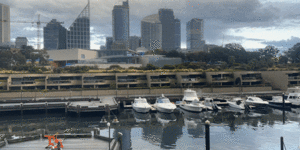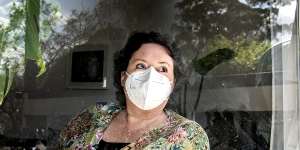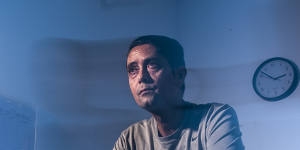Over the past 12 months,she has watched the restaurants gradually fill,listened to the pubs becoming rowdier and heard the occasional rendition ofHappy Birthday floating by. It’s bittersweet;she hasn’t been in the same room as her family for almost three years.
“Those were the signs of the world returning to normal,but they were also the signs of the world becoming the most dangerous it had been to me,” she said.
“It’s a very strange thing to feel comforted by it,but also to feel like I was being left behind.”

The view from Nicola West’s apartment on Finger Wharf,Woolloomooloo,in October 2022.Nicola West
Australian Chief Health Officer Paul Kelly has declared the emergency phase of the pandemic over,restaurants and offices have long returned to capacity,and restrictions remain only in a handful of high-risk environments. But despite high vaccination rates and access to treatments such as antiviral medication,COVID-19 remains an ever-present emergency for hundreds across NSW,and many of them are taking extreme measures to avoid the virus.
Contracting coronavirus is not a risk West nor her doctors can afford to take. A seven-centimetre metal stent – placed during life-changing but experimental neurosurgery in 2011 – is in a part of the brain associated with a high risk of blood clots in COVID-19 patients.
The last time the 33-year-old was out in the world,she was meeting publishers in a bidding war for her debut novel. The World Health Organisation declared a pandemic the next day,and she has left her apartment only a handful of times since,to receive vaccinations.
“I speak to[Mum] literally every day,but every couple of months or so,she’ll just break down on the phone and start crying and say how upset she is that she hasn’t been able to give me a hug,” she said. “Then she’ll apologise and she’ll say,‘I know that I can’t hug a dead you’.”
‘When people are reduced to being an immunocompromised person or a vulnerable person,you take away their story.’
Libby Kinsela,leukaemia survivor
Libby Kinsela is one of roughly 5000 people diagnosed with blood cancer each year in NSW who are particularly vulnerable to coronavirus. Her immune system was “wiped out” by bone marrow transplant treatment for leukaemia 12 months ago and is further suppressed by medication used to manage graft versus host disease,in which the body rejects the transplant.

Libby Kinsela,who received a bone marrow transplant for leukaemia in September 2021,leaves her home only for medical appointments and the occasional walk.Steven Siewert
She leaves her home in Jannali,in Sydney’s south,only for medical appointments or for the occasional masked walk with friends.
She said it was hard not to feel abandoned by the government with mask and isolation restrictions now gone and worries that,if she died with COVID,her death would be dismissed as a consequence of her underlying health conditions.
“When people are reduced to being an immunocompromised person or a vulnerable person,you take away their story;you take away the impact of their life and their value as a human being to society as a whole,” she said.
“The personal stories are being lost.”
Sydney haematologist Associate Professor Nada Hamad said the risk of death among blood cancer patients was about 30 per cent,a statistic that continued to cause great anxiety in her patients.
She said that although blood cancer patients in line for chemotherapy and transplants had to take some hygiene precautions before the pandemic,COVID-19 was “a very different kettle of fish” to other common infectious diseases.
“COVID actually affects every organ needed for metabolising chemotherapy – you need your heart,you need your lungs to actually function,” she said. “We cannot compare COVID to the flu. It’s just a false comparison.”

Matt Heyburgh is training to compete at the Transplant Games in Perth next year,where he will play soccer for the first time since his leukaemia diagnosis in 2019.Steven Siewert
Matt Heyburgh was used to wearing masks,washing his hands and isolating before they became daily fixtures in the lives of most,having received a stem cell transplant in 2019. He contracted COVID-19 in May 2022 but avoided the worst symptoms – a result he attributes to having had four vaccine doses and immediate access to antivirals.
He is training for the Transplant Games in Perth in April,when he will play soccer for the first time since his diagnosis three years ago. He said contracting COVID-19 had eased many of the anxieties he had about the virus.
“Like a lot of people who’ve had a life-saving transplant,you also don’t want to sit at home for the rest of your life,” he said. “For me,it’s about balancing the risk with a real desire to make the most of this second chance at life.”
Associate Professor Bette Liu,an epidemiologist at UNSW who has researched outbreaks of the Omicron variant in indoor settings,said vaccines and access to antivirals had undoubtedly made the world much safer for people such as Heyburgh.
“We are fortunate to be in the position where we have both vaccines and antiviral treatments,and someone with a stem cell transplant who is at high risk will benefit from these,” she said.
There were 3.6 million reported cases of COVID-19 in NSW in 2022. The virus has claimed nearly 6000 lives in the state since March 2020.
Last year,the federal government expanded the eligibility for subsidised COVID-19 antiviral treatments to include immunocompromised people over 18. Health Minister Mark Butler said in September that.
of data from 27,000 Victorians aged over 70 years by the state’s health department found the antiviral Paxlovid reduced the risk of hospitalisation by 32 per cent and the risk of death by 72 per cent,while an alternative medication,Lagevrio,reduced the risk of hospitalisation by 26 per cent and death by 54 per cent.
The full analysis is yet to be published or independently verified by other scientists.
West had seen antivirals as a light at the end of the tunnel but,more than a thousand days into her isolation,learnt she couldn’t take them due to a potentially lethal contraindication with a medication she takes for a separate condition.
“I’ve had a lot of ups and downs during my isolation,but I don’t think I’ve ever felt so defeated,” she wrote in an email to theHerald.
“I’ve sacrificed so much of my life over the past two-and-a-half years to keep myself safe,and it feels like it’s all been for nothing – like I’ve just been prolonging the inevitable.”
West has adjusted to life confined to her apartment. She works at night when the wharf is quietest,waking up when most are coming home from work and going to bed as the sun comes up.
She is writing her next novel,about a night owl trapped in her apartment who witnesses a murder from her window,and hopes to tour the book next year.
“To this day,I haven’t even seen my[debut] book in the flesh,” she said. “I would be so thrilled if,when this second book comes out,I could go to a bookstore and see it there.”